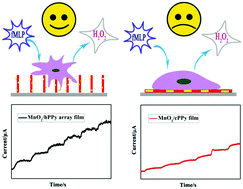A novel H2O2 biosensor based on three-dimensional micro/nano-biointerfaces†
Abstract
To detect hydrogen peroxide (H2O2) that is released in situ by cells is a challenge because of its high activity and short life time. Here, a new type of H2O2 biosensor was reported based on three-dimensional (3D) micro/nano-biointerfaces as an amicable platform to promote cell adhesion, and which can directly grow living cells on manganese dioxide (MnO2) immobilized onto a novel hollow horn-like morphology polypyrrole (hPPy) film. The composite MnO2/hPPy array films were characterized by scanning electron microscopy (SEM), energy dispersive spectroscopy (EDS) and elemental mapping. Further, the results of a cell adhesion test indicated that the as-obtained 3D micro/nano-array films had good cell adhesion. This proposed sensing platform provided high electroactivity and excellent electron transport with a lower detection limit, a higher sensitivity and a short diffusion distance to reaction sites by electrochemical study. The new design strategy we proposed can expand the bioapplication of 3D micro/nano-biointerfaces that can guide cell fate and electrochemical detection in cell biology.



 Please wait while we load your content...
Please wait while we load your content...